
Deng Xiaoping was a Chinese politician who was the paramount leader of the People's Republic of China from 1978 until his retirement in 1992. After Chairman Mao Zedong's death in 1976, Deng gradually rose to power and led China through a series of far-reaching market-economy reforms, which earned him the reputation as the "Architect of Modern China."

Mao Zedong, also known as Chairman Mao, was a Chinese communist revolutionary who became the founding father of the People's Republic of China (PRC), which he ruled as the Chairman of the Communist Party of China from its establishment in 1949 until his death in 1976. Ideologically a Marxist–Leninist, his theories, military strategies, and political policies are collectively known as Maoism.

The Cultural Revolution, formally the Great Proletarian Cultural Revolution, was a sociopolitical movement in the People's Republic of China from 1966 until 1976. Launched by Mao Zedong, then Chairman of the Communist Party of China, its stated goal was to preserve Chinese Communism by purging remnants of capitalist and traditional elements from Chinese society, and to re-impose Mao Zedong Thought as the dominant ideology in the Communist Party of China (CPC). The Revolution marked Mao's return to a position of power after a period of less radical leadership to recover from the failures of the Great Leap Forward, whose policies led to famine and approximately 30 million deaths only five years earlier. The Cultural Revolution damaged China's economy while tens of millions of people were persecuted, with an estimated death toll ranging from hundreds of thousands to 20 million. Massacres took place in many places, such as the Guangxi Massacre, the Inner Mongolia incident, and the Daoxian Massacre, while massive local cannibalism also occurred.
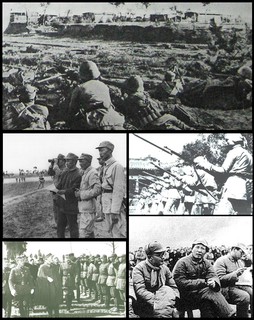
The Chinese Civil War was a civil war in China fought between the Kuomintang (KMT)-led government of the Republic of China (ROC) and the Communist Party of China (CPC) lasting intermittently between 1927 and 1949. The war is generally divided into two phases with an interlude: from August 1927 to 1937, the KMT-CPC Alliance collapsed during the Northern Expedition, and the Nationalists controlled most of China. From 1937 to 1945, hostilities were put on hold, and the Second United Front fought the Japanese invasion of China with eventual help from the World War II Allies. The civil war resumed with the Japanese defeat, and the CPC gained the upper hand in the final phase of the war from 1945–1949, generally referred to as the Chinese Communist Revolution.

The Long March was a military retreat undertaken by the Red Army of the Communist Party of China, the forerunner of the People's Liberation Army, to evade the pursuit of the Kuomintang army. There was not one Long March, but a series of marches, as various Communist armies in the south escaped to the north and west. The best known is the march from Jiangxi province which began in October 1934. The First Front Army of the Chinese Soviet Republic, led by an inexperienced military commission, was on the brink of annihilation by Generalissimo Chiang Kai-shek's troops in their stronghold in Jiangxi province. The Communists, under the eventual command of Mao Zedong and Zhou Enlai, escaped in a circling retreat to the west and north, which reportedly traversed over 9,000 kilometers over 370 days. The route passed through some of the most difficult terrain of western China by traveling west, then north, to Shaanxi.

Peng Dehuai was a prominent Chinese Communist military leader, who served as China's Defense Minister from 1954 to 1959. Peng was born into a poor peasant family, and received several years of primary education before his family's poverty forced him to suspend his education at the age of ten, and to work for several years as a manual laborer. When he was sixteen, Peng became a professional soldier. Over the next ten years Peng served in the armies of several Hunan-based warlord armies, raising himself from the rank of private second class to major. In 1926 Peng's forces joined the Kuomintang, and Peng was first introduced to communism. Peng participated in the Northern Expedition, and supported Wang Jingwei's attempt to form a left-leaning Kuomintang government based in Wuhan. After Wang was defeated, Peng briefly rejoined Chiang Kai-shek's forces before joining the Chinese Communist Party, allying himself with Mao Zedong and Zhu De.
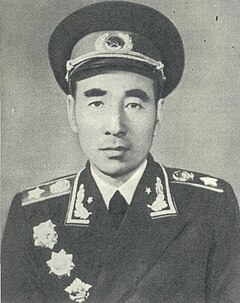
Lin Biao was a Marshal of the People's Republic of China who was pivotal in the Communist victory in the Chinese Civil War, especially in Northeast China. Lin was the general who commanded the decisive Liaoshen and Pingjin Campaigns, in which he co-led the Manchurian Field Army to victory and led the People's Liberation Army into Beijing. He crossed the Yangtze River in 1949, decisively defeated the Kuomintang and took control of the coastal provinces in Southeast China. He ranked third among the Ten Marshals. Zhu De and Peng Dehuai were considered senior to Lin, and Lin ranked directly ahead of He Long and Liu Bocheng.

The Sino-Soviet split (1956–1966) was the breaking of political relations between the People's Republic of China (PRC) and the Union of Soviet Socialist Republics (USSR), caused by doctrinal divergences that arose from their different interpretations and practical applications of Marxism–Leninism, as influenced by their respective geopolitics during the Cold War (1945–1991). In the late 1950s and early 1960s, Sino–Soviet debates about the interpretation of orthodox Marxism became specific disputes about the USSR's policies of national de-Stalinization and international peaceful coexistence with the Western world, which Mao decried as Marxist revisionism. Against that ideological background, China took a belligerent stance towards the West, and publicly rejected the USSR's policy of peaceful coexistence between the Eastern bloc and the Western bloc.
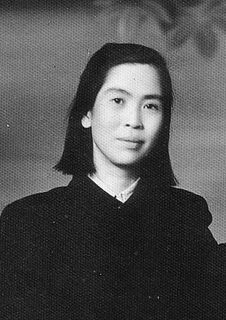
He Zizhen was the third wife of Chairman Mao Zedong from May 1930 to 1937.
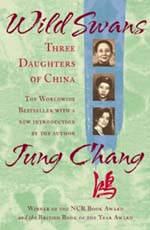
Wild Swans: Three Daughters of China is a family history that spans a century, recounting the lives of three female generations in China, by Chinese writer Jung Chang. First published in 1991, Wild Swans contains the biographies of her grandmother and her mother, then finally her own autobiography. The book won two awards: the 1992 NCR Book Award and the 1993 British Book of the Year. The book has been translated into 37 languages and sold over 13 million copies.
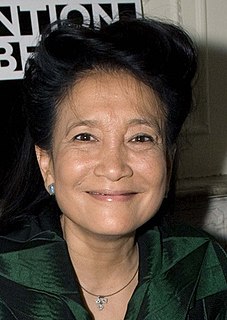
Jung Chang is a Chinese-born British writer now living in London, best known for her family autobiography Wild Swans, selling over 10 million copies worldwide but banned in the People's Republic of China.
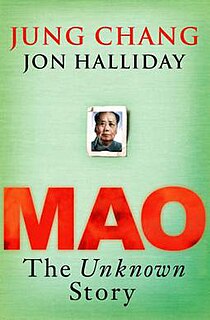
Mao: The Unknown Story is a 2005 biography of Chinese Communist leader Mao Zedong (1893–1976) written by the wife and husband team of writer Jung Chang and historian Jon Halliday, who depict Mao as being responsible for more deaths in peacetime than Adolf Hitler or Joseph Stalin.

Red Star Over China, a 1937 book by Edgar Snow, is an account of the Communist Party of China that was written when it was a guerrilla army and still obscure to Westerners.
The Shanghai massacre of April 12, 1927, known commonly in China as the April 12 Purge or April 12 Incident, was the violent suppression of Communist Party of China (CPC) organizations in Shanghai by the military forces of Generalissimo Chiang Kai-shek and conservative factions in the Kuomintang. Following the incident, conservative KMT elements carried out a full-scale purge of Communists in all areas under their control, and even more violent suppression occurred in Guangzhou and Changsha. The purge led to an open split between left and right wing factions in the KMT, with Chiang Kai-shek establishing himself as the leader of the right wing faction based in Nanjing, in opposition to the original left-wing KMT government based in Wuhan led by Wang Jingwei.
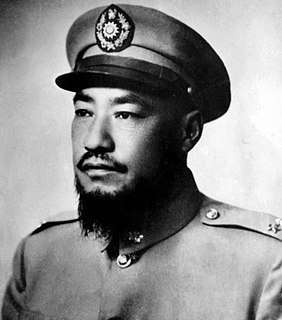
Ma Bufang (1903 – 31 July 1975) (traditional Chinese: 馬步芳; simplified Chinese: 马步芳; pinyin: Mǎ Bùfāng; Wade–Giles: Ma3 Pu4-fang1, Xiao'erjing: ما بوفنگ) was a prominent Muslim Ma clique warlord in China during the Republic of China era, ruling the province of Qinghai. His rank was Lieutenant-general.
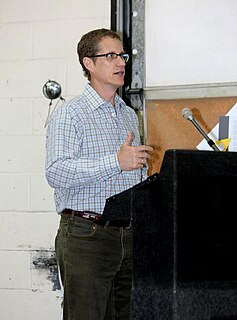
Dean King is an American author of narrative non-fiction on adventure, historical and maritime subjects. His books include Skeletons on the Zahara (2004) and Unbound (2010), both published by Little, Brown. He is the author of companion books to Patrick O'Brian's Aubrey-Maturin series of novels and is the first biographer of O'Brian. In his biography, Patrick O'Brian: A Life (2000), which was excerpted in four full pages in the Daily Telegraph in London, King revealed that O'Brian was not really of Irish origin, as O'Brian claimed, and that he had changed his name by deed poll in London in 1945. King has also published articles in The New York Times, National Geographic Adventure, New York Magazine, Outside and other magazines and newspapers.
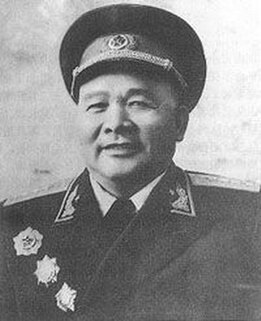
Xu Haidong was a senior general in the People's Liberation Army of China.

The Ngolok rebellions (1917–1949) were a series of military campaigns against unconquered Ngolok (Golok) tribal Tibetan areas of Qinghai (Amdo), undertaken by two Hui commanders, Gen. Ma Qi and Gen. Ma Bufang, on behalf of the Beiyang and Kuomintang governments of the Republic of China. The campaigns lasted between 1917 and 1949.
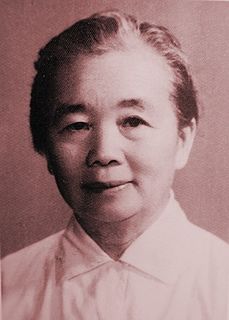
Zhang Qinqiu was a Chinese Communist revolutionary, military commander, and politician. She was one of the first female members of the Communist Party of China, and one of the 28 Bolsheviks trained in Moscow. A high-ranking commander of the Fourth Front Army of the Chinese Red Army during the Long March, she is often considered the only woman general of the Red Army. After the founding of the People's Republic of China, she served as Deputy Minister of Textile Industry. She was persecuted during the Cultural Revolution and committed suicide in 1968.
Serve the People! is a 2005 novel by Yan Lianke. The English version, translated by Julia Lovell, was published in 2010 by Black Cat/Grove.


















